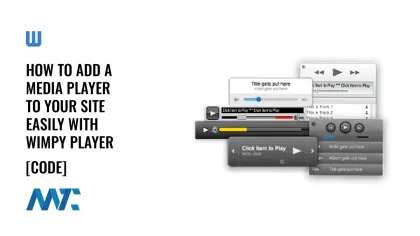
A few of our clients needed a friendly media player for their sites that was simple to implement I was looking for a modern audio player that would work across browsers and devices. I found Wimpy Player, an incredibly simple yet robust player for audio and video files. With its user-friendly interface and comprehensive features, the Wimpy Player is the ultimate solution for delivering flawless audio and video content experiences online.
Wimpy Player is designed to support a range of audio and video file types, ensuring a seamless multimedia experience for your users. Here’s a list of some supported file formats:
Wimpy Player employs modern web technologies to ensure a smooth multimedia experience across various devices and browsers. Some of these technologies include:
- HTML5: Harness the power of HTML5 for efficient multimedia content delivery.
- CSS3: Customize and style your player consistently using the capabilities of CSS3.
- JavaScript: Add interactive elements to your content with seamless JavaScript integration.
- API Power: Leverage Wimpy Player’s API to seamlessly integrate your existing systems.
Wimpy’s Features Include
- Customized Appearance: Easily match your player’s look to your website’s design using the Wimpy Button and CSS Player.
- Personalized Skins: Choose from a range of pre-designed skins or create your unique look with the Skin Machine.
- Seamless Integration: Integrate Wimpy Player’s features seamlessly into your existing workflows using the API.
- Effortless Content Management: Manage and access your multimedia content effortlessly with optimized URL paths.
- Modern Browser Usage: Opt for modern browsers like Mozilla Firefox, Google Chrome, or Apple Safari for optimal performance.
- DOCTPYE Declaration: Ensure your HTML code includes the necessary DOCTYPE declaration to unlock advanced features.
- Source Code Editing: Utilize dedicated source code editors to prevent formatting errors and the misrepresentation of special characters.
How To Build A Wimpy Player For An MP3 File
To include an MP3 file using Wimpy Player, follow these steps:
- Upload your MP3 file to your web server.
- Ensure you have the Wimpy Player code integrated into your webpage.
- Use the following code to include your MP3 file:
<!DOCTYPE html>
<html>
<head>
<title>Wimpy Player Example</title>
<!-- Include Wimpy Player CSS file -->
<link rel="stylesheet" type="text/css" href="path-to-wimpy-player.css">
</head>
<body>
<!-- Place the Wimpy Player container where you want the player to appear -->
<div id="my-wimpy-player"></div>
<!-- Include Wimpy Player JavaScript file -->
<script type="text/javascript" src="path-to-wimpy-player.js"></script>
<script type="text/javascript">
wimpyPlayer.setup({
url: 'path-to-your-mp3-file.mp3',
// Other configuration options here
});
</script>
</body>
</html>Replace 'path-to-your-mp3-file.mp3' with the actual path to your MP3 file on your server.
How To Build A Wimpy Player For A Playlist
Wimpy Player allows you to create playlists for a seamless playback experience. Here’s an example of how to include a playlist with multiple audio files:
<!DOCTYPE html>
<html>
<head>
<title>Wimpy Player Example</title>
<!-- Include Wimpy Player CSS file -->
<link rel="stylesheet" type="text/css" href="path-to-wimpy-player.css">
</head>
<body>
<!-- Place the Wimpy Player container where you want the player to appear -->
<div id="my-wimpy-player"></div>
<!-- Include Wimpy Player JavaScript file -->
<script type="text/javascript">
wimpyPlayer.setup({
playlist: [
{ title: 'Song 1', url: 'path-to-song1.mp3' },
{ title: 'Song 2', url: 'path-to-song2.mp3' },
// Add more songs as needed
],
// Other configuration options here
});
</script>
</body>
</html>Replace 'path-to-song1.mp3' and 'path-to-song2.mp3' with the actual paths to your audio files on the server.
How To Build A Wimpy Player For An MP4 Video
- Upload your MP4 video file to your web server.
- Ensure you have the necessary Wimpy Player files (JavaScript and CSS) integrated into your webpage. You might need to download these files from the Wimpy Player’s official website.
- Use the following code example to include the Wimpy Player for your MP4 video:
<!DOCTYPE html>
<html>
<head>
<title>Wimpy Player Example</title>
<!-- Include Wimpy Player CSS file -->
<link rel="stylesheet" type="text/css" href="path-to-wimpy-player.css">
</head>
<body>
<!-- Place the Wimpy Player container where you want the player to appear -->
<div id="my-wimpy-player"></div>
<!-- Include Wimpy Player JavaScript file -->
<script type="text/javascript" src="path-to-wimpy-player.js"></script>
<script type="text/javascript">
// Set up the Wimpy Player
wimpyPlayer.setup({
url: 'path-to-your-mp4-video.mp4',
type: 'video',
// Other configuration options here
});
</script>
</body>
</html>Replace 'path-to-wimpy-player.css' and 'path-to-wimpy-player.js' with the actual paths to the Wimpy Player CSS and JavaScript files on your server.
Replace 'path-to-your-mp4-video.mp4' with the actual path to your MP4 video file on your server.
Note: Make sure to customize the configuration options according to your needs, such as auto-start, player controls, and styling.
With Wimpy Player’s support for various file formats and easy integration methods, you can deliver a dynamic multimedia experience that engages your audience with audio and video content.
Transform your multimedia content delivery with the Wimpy Player’s intuitive interface, customizable options, and advanced technologies. Whether you’re a content creator, marketer, or developer, the Wimpy Player empowers you to provide an engaging experience that captivates your audience. Elevate your online presence with the Wimpy Player today!
Download Wimpy Player[/button/